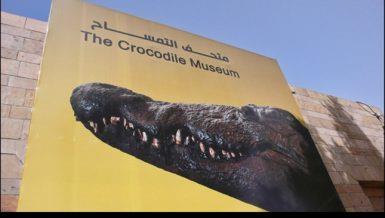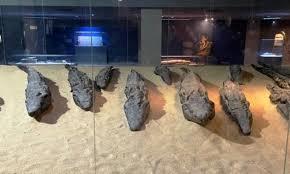(MENAFN- Daily News Egypt) Standing beside the ancient Kom Ombo Temple in southern Egypt, the Crocodile Museum offers a unique portal into the beliefs and rituals of the ancient Egyptian civilization. Opened in 2012, this museum is a monument to Sobek, the crocodile-headed god revered for his association with the Nile River's life-giving power and fertility. The museum's diverse collection highlights the profound role crocodiles played in ancient Egyptian society, revealing the interplay between nature, worship, and burial practices.

Crocodile Museum
A God of the Nile
In ancient Egyptian mythology, Sobek was more than a mere god. He was a force of nature, embodying the Nile's life-sustaining power and the fearsome strength of the crocodile. He was a complex deity, simultaneously revered for his nurturing side, providing sustenance and prosperity through the fertile land nourished by the Nile, and for his fierce, protective nature, defending the land from threats. This duality is reflected in his imagery, often depicted as a powerful crocodile but also as a benevolent figure with human hands or carrying the ankh, the symbol of life.
The Egyptians believed Sobek protected the pharaohs, ensuring their strength and longevity, and his presence was invoked for fertility and protection. This reverence for Sobek is evident in archaeological discoveries throughout Egypt, including statues, inscriptions, and even temples dedicated to the deity. One such testament to his significance is the Kom Ombo Temple, standing as a magnificent example of architectural prowess and a powerful reminder of Sobek's role in ancient Egyptian life.

Crocodile Museum: Unveiling Secrets of Ancient Egyptian Beliefs
A Temple to Two Gods
The Crocodile Museum sits next to the Kom Ombo Temple, a monumental structure dedicated to both Sobek and the falcon god Horus. Built during the Ptolemaic period, the temple reflects the complex duality of ancient Egyptian beliefs. Its unique double-temple design, with two separate sanctuaries, speaks to the Egyptians' belief in the interconnectedness of the divine and their understanding of the cosmos. Visitors often explore both the temple and museum, gaining a comprehensive understanding of the area's historical and spiritual significance. The Kom Ombo Temple, with its intricate carvings, towering pillars, and symbolic representations, stands as a powerful reminder of the ancient Egyptians deep devotion to their gods.
A Glimpse into the Afterlife
The museum's main exhibition hall showcases a striking collection of mummified Nile crocodiles, offering a glimpse into ancient Egyptian rituals. The largest specimen measures an impressive 4.30 metres, while the smallest is 2 metres long. These mummies are not only fascinating due to their size but also because they represent the ancient Egyptians' profound belief in the afterlife and their intricate burial practices. For the Egyptians, death was not an end, but a transition to another world, and they believed that individuals needed to be equipped with everything they needed for their journey into the afterlife.
Beyond the Mummies
Beyond the mummies, the museum houses a wealth of intriguing artefacts. These include crocodile foetuses, preserved eyes, and golden and ivory teeth. These objects serve as poignant reminders of the reverence ancient Egyptians held for crocodiles, seeing them as sacred creatures worthy of special treatment in death. The Egyptians believed that the afterlife was a place of eternal life and that individuals could be reunited with their loved ones. The mummified crocodiles, along with the other artefacts, provide a fascinating window into this world, revealing the Egyptians' deep connection to the natural world and their intricate belief systems.

Crocodile Museum: Unveiling Secrets of Ancient Egyptian Beliefs
Depictions of Sobek
The museum also showcases statues of Sobek in various sizes, each depicting the god in his iconic form. These statues are not just artistic creations, but testaments to the worship practices surrounding Sobek and the artistic styles prevalent during different periods of ancient Egyptian history. Each statue tells a story of devotion, craftsmanship, and the cultural significance of this powerful deity. They range from small, intricately carved figurines to towering statues, reflecting the diverse range of artistic expression in ancient Egypt.
Rituals of the Dead
A highlight of the museum is a model of a tomb that recreates discoveries from the Shutb cemetery. This exhibit provides valuable insight into ancient Egyptian burial practices, particularly in relation to crocodiles. The model showcases pottery coffins that once contained the mummies of these revered creatures, revealing the elaborate rituals associated with their death and burial. The Egyptians believed that the afterlife was a place where individuals could be reunited with their loved ones and that they needed to be equipped with everything they needed for their journey into the next world.
A Gateway to Ancient Knowledge
The Crocodile Museum serves as an invaluable educational resource, offering visitors a unique opportunity to explore the intersection of nature and religion in ancient Egypt. Through its exhibits, the museum fosters an understanding of the cultural and spiritual significance of crocodiles, promoting a deeper appreciation for Egypt's rich history. The museum provides a captivating glimpse into a world where the natural and the supernatural were intricately intertwined and where crocodiles were seen not as mere creatures, but as powerful symbols of the divine.
From Antiquity to the Present
In contemporary Egypt, crocodiles still hold a place in the cultural imagination, even as reverence for Sobek may have diminished. The Crocodile Museum serves as a bridge between ancient beliefs and modern interests, attracting both tourists and locals alike. The museum's exhibits remind us that the ancient Egyptians were deeply connected to the natural world, and their beliefs and rituals continue to hold relevance even today.
Exploring the Museum
Visitors to the Crocodile Museum can expect a well-curated experience that combines education with intrigue. The museum's layout is designed to guide guests through the history and significance of Sobek and crocodiles in ancient Egypt, making it accessible for all ages. Informational plaques accompany each exhibit, providing context and deepening the visitor's understanding of the artefacts on display. The museum's friendly staff is also available to answer questions and provide insights into the ancient world.
A Legacy of Reverence
The Crocodile Museum stands as a testament to the enduring legacy of ancient Egyptian culture. Through its remarkable collection of mummified crocodiles, statues of Sobek, and insights into burial practices, the museum offers a unique glimpse into the beliefs and rituals of a civilization that revered the natural world. As visitors explore the exhibits, they not only learn about ancient worship but also come to appreciate the intricate relationship between humanity and nature that continues to resonate in modern times. Whether you are a history buff, a lover of art, or simply curious about ancient Egypt, the Crocodile Museum is a destination that promises to inspire and educate.
MENAFN02092024000153011029ID1108628546
Legal Disclaimer:
MENAFN provides the information “as is” without warranty of any kind. We do not accept any responsibility or liability for the accuracy, content, images, videos, licenses, completeness, legality, or reliability of the information contained in this article. If you have any complaints or copyright issues related to this article, kindly contact the provider above.